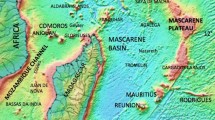Abstract
Until recently, concepts of coral reef growth and accumulation have been predominantly based on a Darwinian model. In this, the upwards and outwards growth of a reef core (a coral framework) takes place over a foreslope consisting of reef talus, with the simultaneous filling of the back-reef lagoon by reef-derived debris. The principal adaptations of this pattern relate to the influence of relative changes in sea level and commonly ignore oceanographic factors such as storm frequency and severity. Boreholes through the outer edge of a fringing reef in the Seychelles, western Indian Ocean, reveal a record of Holocene sediment accumulation first established approximately 8 ka ago. Faunal and floral associations show that growth of this body began in relatively deep water but that this shallowed to <5 m within 1 ka. Subsequent accumulation was of “keep-up” style but, as the rate of sea-level rise slowed, shoaling became more frequent and aggradation was limited by reducing accommodation space. Constructional facies are characterised either by massive corals, including Leptastrea, Porites and faviids, or by branching corals, typically Acropora of the danai-robusta group. Coral surfaces may be encrusted by red algae, foraminifera and vermetids, and are commonly bored by filamentous algae, clionids and molluscs. However, detrital facies are volumetrically dominant, and the paucity of a constructional framework requires a re-evaluation of models of reef accretion. New models relate the geometry of accretion to the interplay between extreme storm events and fairweather hydrodynamic conditions. These suggest that a contiguous framework forms in areas of moderate fairweather energy without extreme storm events. Severe storms destroy the continuity of reef structures and generate increasing volumes of coarse detritus. Low storm severity, coupled with low fairweather hydrodynamic energy, may promote the accumulation of fine-grained reef-derived sediments that inhibit framework growth. While ecology reflects year-by-year sea conditions, lithology and structure are controlled by exceptional storms, with the effects of changing sea level superimposed.
Similar content being viewed by others
Author information
Authors and Affiliations
Additional information
Received: 30 November 1998 / Accepted: 4 November 1999
Rights and permissions
About this article
Cite this article
Braithwaite, C., Montaggioni, L., Camoin, G. et al. Origins and development of Holocene coral reefs: a revisited model based on reef boreholes in the Seychelles, Indian Ocean. Int Journ Earth Sciences 89, 431–445 (2000). https://doi.org/10.1007/s005310000078
Issue Date:
DOI: https://doi.org/10.1007/s005310000078




